So you’re looking to purchase an entry-level DSLR camera, and whilst browsing your options, you came across the Canon 1200D, also known as the Canon Rebel T5, and you might have also noticed the Canon 1300D, also known as the Rebel T6.
In this article, we’ll go over the differences between the two cameras, what they can, and can’t do, and which one you should buy.

Size & Build
In terms of physical size, they’re both actually quite small. It’s no secret that I actually prefer larger, beefier cameras, as I am a big boy, so when in my hand, both manage to basically look like toys.
With that in mind, if you’re a regular person, either of these Cameras will be very comfortable to carry around, whether you stash them in your backpack, or you hold them in your hand.
When it comes to actual dimentions, the Canon 1200D measures 129.6mm x 99.7mm x 77.9mm, and weighs in at around 480g, with battery and card included.
The 1300D measures 129.0mm x 101.3mm x 77.6mm, and weighs around the same, at 485g, with battery and card.
So, they’re basically really portable, easy to carry, and they’re the same size.
Ok, so they’re small. What can they do though?

Image Quality
When it comes to image quality, they both have the same 22.3mm x 14.9mm 18 MP CMOS Sensor. I’ll show you some photos I took with each in a minute, but first, let’s talk a bit about what this really means.
So the 1200D and 1300D were released in February 2014, and March 2016 respectively. Camera sensors have come a long way since then, but that doesn’t mean that you can’t take great photos with these older cameras.
One of the general rules of thumb in photography and videography is that it’s more about the person behind the camera, not the equipment being used. A camera is just a tool.
Some of the most famous photographs in existence were captured with very rudimentary equipment. All that the camera can do is make it easier for you to do your work.
In fact, the way photos look actually has more to do with the lenses, than with the camera bodies. I’ve actually reviewed quite a few lenses on my YouTube channel.
Autofocus
When it comes to autofocus, both of these cameras have 9 AF points, which isn’t great by today’s standards, and neither of them has Canon’s legendary Dual Pixel AF.
Your camera will autofocus, it’s just that it will be a bit more of a pain to do so, which is actually great news, and I’ll explain in a bit why that is.

ISO
When it comes to ISO, both can do 100 to 6400, and you can expand their range to 12800 if you wish. The T5 has the DIGIC 4 processor, whilst the T6 has the upgraded DIGIC 4+ processor.
What this means in practical terms, is that if you take some photos in low light, and you bump up the ISO in order to brighten up the picture, the T6 is probably going to be a tiny bit better at reducing some of the unwanted noise in the photo.
Sports or Wildlife
If you’re looking to capture sports, or wildlife, in continuous mode, both cameras can do 3fps. So in the span of one second, they can capture 3 different photos, thus hopefully freezing motion, when desired.
This isn’t great by modern standards either, but at least you have the option. Now that I’ve explained how inadequate these two cameras are, why should you buy them?
If you’re a creative type of person, you’ve probably encountered the notion that limitation breeds creativity. In other words, when you’re operating in an environment where you have limitless options, this can have a paralysing effect, whilst limiting yourself can inspire.
Learning on cameras such as these will definitely limit you, especially by today’s standards, which will force you to creatively solve problems.
In addition to that, the limitations of these two cameras will also force you to learn how to use them properly.
Expensive Cameras
If you’re using something like the Canon R5, it’ll nail focus every time, it’ll find eyes in frame, and focus on them, it’ll expose shots, etc. The problem is that, if the camera is already doing this for you, why learn yourself?
When using either of these cameras, they might struggle to focus in some scenarios, which will force you to figure out why that is. They won’t expose properly in Auto mode, which will force you to switch to Manual mode, and figure out how to juggle aperture, shutter speed, and ISO.
By doing so, when it’s time to graduate to a more expensive camera, you’ll be able to get so much more out of it, as you’ll understand how it actually works, instead of depending on its automated built-in features.

Video
Both the Canon 1200D and 1300D can shoot 1080p @ 30fps, and 720p @ 60fps. If you’re looking to shoot some slow-motion stuff, you’ll basically be limited to 720p, which isn’t great in 2022.
While these specs won’t impress anyone now, bear in mind that this is a learning opportunity in disguise. Why not challenge yourself to shoot stuff at 30fps, but then try to make it look like it was done in slow motion?
Not happy with how the shot looks? Perhaps try a different lens, or maybe play with the light available to you, in order to change the way that a shot feels.
Given that, ideally, your shutter speed is synced to your frame rate, the only things that you’ll be able to change are your aperture and ISO. This is because, normally, you want your shutter speed to be double your frame rate when shooting video.
So, if you’re shooting in 1080p @ 30fps, you want your shutter speed to be 1/60s, or as close to that as possible. Now, since that can’t be changed, and maybe you’ve hit the lower limit of ISO, and you don’t want to mess with your aperture, your only option is to physically manipulate the light in the room.
If it’s too bright, maybe you can move a bit further from the window? Maybe you can put up some shear curtains, to diffuse some of that light? Perhaps you can draw your blackout curtains a little bit, to allow less light.
What does that look like? Does it concentrate the light? How does that look on the subject?
See what I mean? When you’re limited by your tools, you’re forced to change your environment, and that’s where the real learning comes from.
Vlogging
Now that we’re talking about video, can either of these cameras be used for vlogging?
Um, technically, yes.
Now, both have 3″ screens on the back, but neither is adjustable. That means that you can’t turn them, flip them, or do anything really.
Now, that doesn’t necessarily stop you from vlogging, but it’s a limitation that you should be aware of.
Also, they both have cropped sensors, which basically zoom the image in, compared to a full-frame sensor. What that means is that if you’re holding the camera in your hand, using a lens like the Canon EF 50mm f1.4, or Canon EF 50mm f1.8 will result in images that are far too zoomed in to be useable.
As a result, you might want to have a look at something like the Canon EF-S 18-55mm kit lens, especially if it has IS in the name. The IS stands for image stabilisation, and it will do just that, allowing you to produce much more stable footage.
In addition to that, the fact that you can zoom the lens all the way out to 18mm means that you can capture more, theoretically allowing more of your upper body to be in frame.
Again, I have a playlist on my YouTube channel to have a look at some of my lens reviews.
Now, what if you don’t want to be a vlogger, but just use it to shoot content for online platforms, like YouTube?

YouTubers
Well, you can indeed just pop either of these cameras on a stand, and achieve some pretty good-looking video, especially if you’re using a lens like the aforementioned EF 50mm f/1.4 or f/1.8.
You’d need to have a bit of room though, as there will have to be quite a bit of space between you and a lens like that, due to it being quite zoomed in.
Also, I’m not 100% sure how well either of these cameras will be able to autofocus with your aperture being set to f/1.4, or even f/1.8.
Again, more limitations to deal with and problems to creatively solve. As they say, it’s not a bug, it’s a feature.
Control
In terms of control, neither have any particularly amazing features. It’s all pretty standard entry-level Canon stuff, without any bells and whistles.
Storage
When it comes to storage, as you might perhaps expect, both the T5 and the T6 can only take one SD card. Whilst more expensive cameras can sometimes have a dual card slot, entry-level cameras always have one.
Now, this isn’t necessarily a problem, as the reason why more expensive cameras take two cards, is so that you can backup your work in real-time.
In the unlikely event that one of your SD cards fails, you have the other one to recover data from. Now, I’ve done professional gigs with cameras that only had one SD card, and I’ve never had any issues, but I would occasionally take breaks to transfer all the files to my laptop, just in case.
You’re probably not likely to do any professional gigs with the Canon 1200D, or 1300D, but it’s worth knowing that, in the future, when you upgrade, you might need a dual card slot.
Battery Life
When it comes to battery life, both cameras use the Canon LP-E10 battery, and they’re both rated for around 500 shots. Bear in mind that this applies to new batteries though.
As batteries age, especially if they’ve been used, they can hold less and less charge, so if you’re using original LP-E10 batteries, you’ll probably get fewer than 500 shots.
It’s always best to carry a few spare batteries with you, just in case.
Longevity
When it comes to longevity, both cameras are made out of carbon fibre, glass fibre, and polycarbonate resin. Also, as you might expect, neither of them has any kind of weather sealing, or anything like that.
Basically, make sure you don’t use them in the rain, or a sandstorm, and you should theoretically be fine.
In terms of maximum actuations, I couldn’t find a specific number on either of these cameras, but entry-level Canon cameras tend to be rated for around 100,000 clicks.
What is this maximum actuation thing I’m talking about? Since a camera contains moving mechanical parts, they’re rated for a certain amount of activity, before they become unreliable, or completely stop working.
Every time your camera goes click, that’s an actuation. Basically, you’re probably going to be able to take 100,000 photos with these cameras, before the shutter, theoretically, fails.
Since you’ll be buying either of these second-hand at this point, as they’re both discontinued, it’s a good idea to check how many actuations, or shutter clicks, they already have on board.
This is important to know, as it affects the life that a camera has left, and it obviously also affects the price.
If the seller is unwilling to tell you how many shutter clicks the camera has, it probably has loads, so you’re better off just looking elsewhere.

Connectivity
When it comes to connectivity, the 1300D actually has Wi-Fi capability. I suppose you could connect it to Wi-Fi, and if you install the Canon app on your phone, you can send photos directly to it, but I personally don’t bother with anything like that.
Once I get home from a shoot, I just take the SD card out of my camera, pop it in my laptop, and just copy everything over.
Compatible Lenses
When it comes to compatible lenses, both the 1200D and the 1300D can take EF and EF-S lenses, which means that the number of lenses that you could use with these camera bodies is virtually endless.
Conclusion
So, in conclusion, should you buy the Canon 1200D, 1300D, or perhaps neither?
Obviously, these cameras are very similar to each other, as I’ve outlined in the main body of the review. In fact, the 1300D was made specifically as a replacement for the 1200D.
Even though neither cameras excel at anything in particular, especially by 2022 standards, you can still use them to learn. You can obviously take landscape photos with them, portraits, and even product shots. The lens will actually be a more important choice when it comes to what you want to do.
If you’re just starting to learn, I’d personally just go for the 1200D, as there won’t be a huge difference between the DIGIC 4 and DIGIC 4+ processor. However, if you want the Wi-Fi capability, the 1300D is obviously your choice.
Also, as the 1300D is newer, you’re probably more likely to find one with fewer shutter clicks, compared to the 1200D, which is 2 years older.
Which?
If you’ve already learnt a bit about photography and videography, and you’d like to graduate to something more mid-range, feel free to have a look at the camera review playlists on my channel. You can find links down below, or click the card in the top right corner.
I’ve reviewed all sorts of cameras, from the Canon 77D and 7D MkII, to the Canon R, and Canon R5.
If you’d like to purchase any of the items I’ve mentioned in this article, or see how much they cost in your country, I have a link down below where you can view them.
Thank you for reading my comparison review of the Canon 1200D (Rebel T5) vs Canon 1300D (Rebel T6). I invite you to have a look at some of my other articles. We have something for everyone, whether you’re interested in audio, or cameras and lenses. Alternatively, if you prefer video reviews, feel free to have a look at my YouTube channel.
Product Links
Down below you will find all of the items I talked about in this article.



